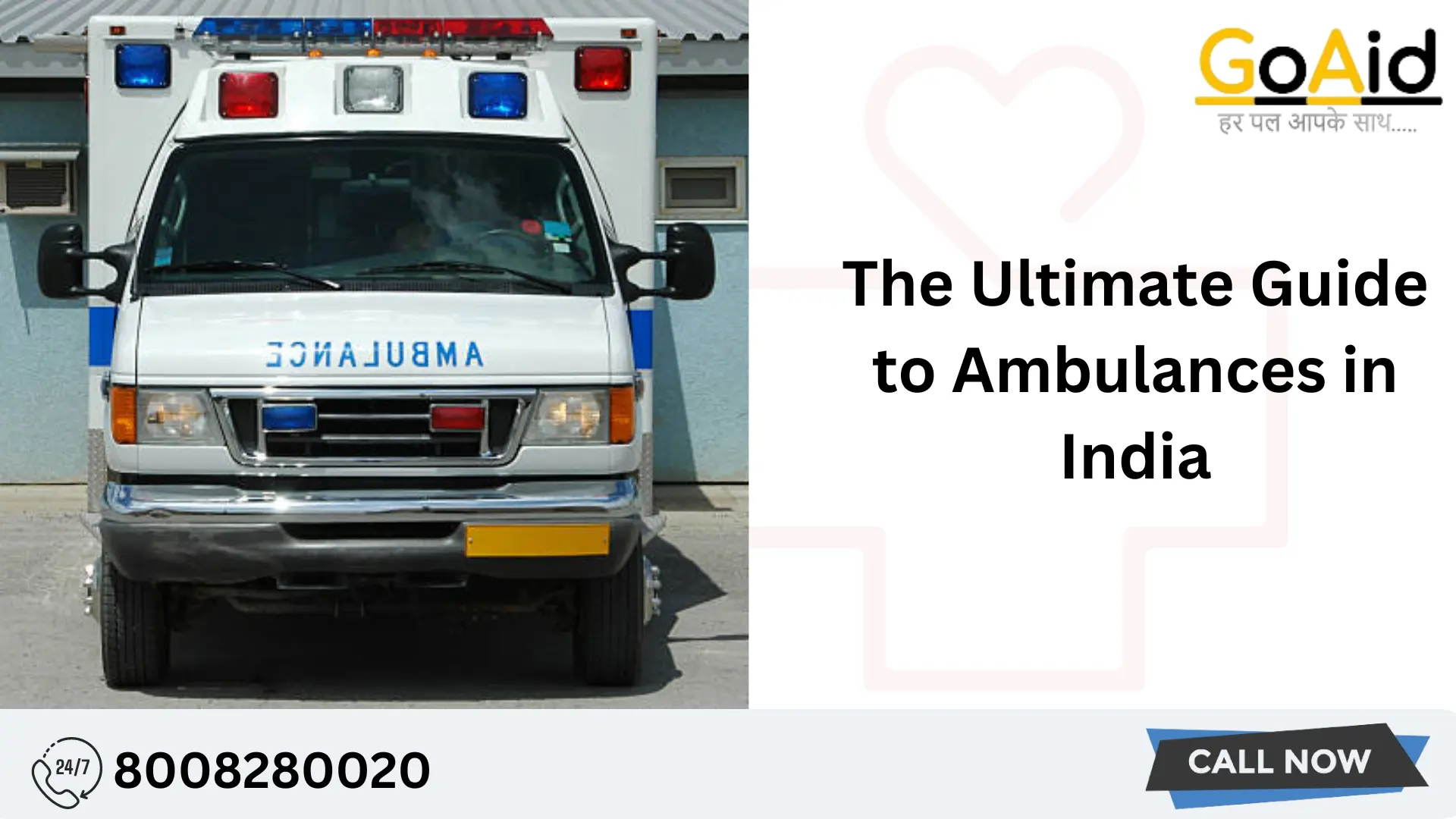There are many things about Ambulances in India that we are not aware of & this is why we need the Ultimate Guide to Ambulance in India including their types & uses. If you are an Indian & want to know everything about Indian Ambulances, then in this blog we have tried to provide you with all the details of Indian Ambulances.
We have added comprehensive details about different types of ambulances in India, Categories of ambulances in India & how to find the best ambulance services near me. If you are excited to know about all these details about Indian Ambulances, then read this blog to the end and also express your thoughts in the comment section.
So, let’s start:
Complete Details About Ambulance Service in India – Types and Uses
We have provided all the details about Ambulance Service in India in this blog below:
What is an Ambulance in India?
Ambulances in India serve as a critical lifeline during medical emergencies. They do it by providing swift transportation and essential care to individuals in need. These vehicles are equipped with medical equipment and staffed by trained professionals who administer immediate aid en route to healthcare facilities.
Ambulances play a crucial role in the healthcare system & ensure timely access to medical treatment and increase the chances of survival for patients. Whether provided by government agencies or private companies, ambulances in India serve as a crucial link between emergencies and necessary medical attention.
Background / History of Indian Ambulance
We can understand the background or History of the Indian Ambulances with these few crucial points:
1. Early Beginnings
Ambulances in India are more focused, Ambulance Services in India trace back to the late 19th century, initially established by British colonial authorities in major cities like Calcutta (now Kolkata) and Bombay (now Mumbai) to transport injured British soldiers.
2. Post-Independence Development
After independence in 1947, the Indian government began formalizing ambulance services, primarily focusing on urban areas and major hospitals.
3. Growth of Public Sector Services
Over the decades, government initiatives expanded ambulance services, particularly in metropolitan regions, with dedicated helplines and emergency medical response systems.
4. Challenges in Rural Areas
Despite urban advancements, rural areas faced challenges in accessing timely medical assistance due to infrastructural limitations, leading to initiatives like mobile medical units and community-based ambulance services.
5. Private Sector Involvement
The late 20th century witnessed the emergence of private ambulance services, offering a range of specialized vehicles and medical expertise, supplementing government efforts.
6. Modernization and Standardization
In recent years, there has been a push towards modernizing ambulance fleets, implementing standardized protocols, and integrating technology for faster response times and improved patient care across the country.
Different Categories of Ambulances in India
In India, ambulance services primarily fall under two main categories:
1. Government Ambulances
These ambulances are operated and managed by government agencies at various levels, including national, state, and municipal authorities. They are often deployed through public healthcare systems and are accessible to citizens at little or no cost. Government ambulances play a crucial role in providing emergency medical services, particularly in underserved areas and during mass casualty incidents.
Full Details: Compared to Private Ambulance Service And Government Ambulance Service
2. Private Ambulances
Private ambulance services are operated by independent companies (Such as GoAid Ambulance Services) or healthcare providers. These ambulances may offer a range of services, from basic transportation to advanced life support, depending on the provider. Private ambulances are often sought after for their efficiency, flexibility, and additional amenities, but they typically come with associated costs that vary depending on the level of care and distance traveled.
Different Types of Ambulance in India

In India, various types of ambulances cater to diverse medical needs and transportation requirements:
- ALS (Advanced Life Support) Ambulance: These ambulances in India are equipped with advanced medical equipment and staffed by trained paramedics or doctors capable of providing advanced life support interventions en route to the hospital.
- BLS (Basic Life Support) Ambulance: These ambulances in India provide basic medical care and transportation to hospitals. These are typically staffed by emergency medical technicians (EMTs) or paramedics trained in basic life support techniques.
Read More: Difference between BLS Ambulance and ALS Ambulance
- Normal Ambulance: These types of ambulances in India offer standard transportation for patients to medical facilities, equipped with basic medical supplies and staffed by trained drivers.
- Air Ambulance: These ambulances in India provide rapid transportation for critically ill or injured patients via helicopter or fixed-wing aircraft. These are equipped with advanced medical equipment and staffed by medical professionals.
- Oxygen Ambulance: These ambulances in India are equipped with oxygen supply systems to cater to patients requiring oxygen therapy during transportation.
- ICU Ambulance: These ambulances in India function as a mobile intensive care unit, equipped with advanced ICU medical equipment and staffed by critical care nurses or physicians to provide intensive care during transportation.
- Surgical Ambulance: These types of ambulances in India are equipped with surgical facilities and staffed by surgeons and surgical teams to perform emergency surgery during transit.
- Interstate – Long Travel Ambulance: These ambulances are specialized for long-distance transportation between states. These are equipped to ensure patient comfort and safety during extended journeys.
- Mortuary Van: These ambulances in India are designed to Mortuary Ven transport deceased individuals and are equipped with facilities for preserving and handling deceased bodies respectfully.
- Dead Body Freezer Box Ambulance: These types of ambulances in India are equipped with refrigerated compartments to preserve Dead Body. These are often used for longer transportation or in cases requiring extended storage.
- Events Ambulance: These ambulances in India are deployed at events, festivals, or gatherings to provide immediate medical assistance and transportation in case of emergencies.
- Train Ambulance: These types of ambulances in India provide medical transportation services on trains, equipped with medical facilities to cater to patients during railway journeys.
- Smart Ambulance: These ambulances in India utilize technology such as telemedicine, GPS tracking, and real-time monitoring systems to enhance efficiency and patient care during transportation.
- Specialized Ambulance: These ambulances in India are tailored for specific medical needs such as cardiac emergencies, trauma, obstetric emergencies, or pediatric care, equipped with specialized equipment and trained personnel.
- Customized Ambulance: These types of ambulances in India can be modified according to specific requirements or preferences, such as wheelchair accessibility, customized transportation, or specialized medical equipment installations.
Top 10 Best Uses of Ambulance in India

These are the top 10 best uses of Indian Ambulances:
1. Emergency Medical Response
Ambulances are crucial for providing rapid medical response during emergencies such as accidents, heart attacks, and strokes, ensuring patients receive timely medical attention en route to the hospital.
2. Transportation of Critically Ill Patients
Ambulances facilitate the safe transportation of critically ill patients who require continuous medical monitoring and care, including those with severe injuries or medical conditions.
3. Neonatal and Pediatric Transport
Specialized ambulances equipped with neonatal and pediatric facilities transport newborns and children requiring specialized medical attention to neonatal intensive care units (NICUs) or pediatric hospitals.
4. Interfacility Transfers
Ambulances facilitate the transfer of patients between healthcare facilities, ensuring seamless transitions for patients requiring specialized care or advanced medical interventions.
5. Emergency Obstetric Care
Ambulances equipped with obstetric facilities provide emergency transportation for pregnant women experiencing complications during childbirth, ensuring safe delivery and timely access to medical care.
6. Critical Care Transport
Advanced ambulances equipped with intensive care facilities transport critically ill patients requiring advanced medical interventions, such as ventilator support or cardiac monitoring, to tertiary care hospitals.
7. Medical Evacuation
Ambulances play a vital role in medical evacuations, transporting injured or sick individuals from remote or inaccessible areas to healthcare facilities equipped to provide appropriate medical treatment.
8. Community Health Initiatives
Ambulances support community health initiatives by facilitating mobile healthcare services, including medical camps, vaccination drives, and health education programs, reaching underserved populations in remote areas.
9. Disaster Response
During natural disasters or mass casualty incidents, ambulances are essential for triaging, treating, and transporting injured individuals to hospitals, ensuring effective disaster response and medical relief efforts.
10. On-the-Spot Treatment
Ambulances in India are equipped with advanced medical equipment and trained personnel, enabling them to provide immediate on-the-spot treatment to patients at the scene of an emergency. This capability is particularly crucial in situations where immediate medical intervention can significantly improve patient outcomes.
How to Find the Best Ambulance Service Near Me in India?
These are the top 10 tips that will help you to find the best ambulance services near you:
- Research Online: You can begin your search for the best ambulance service nearby by browsing online. Look for websites or directories listing ambulance services in your area.
- Check Reviews and Ratings: Many platforms offer reviews and ratings from previous users. You can read through these to get an idea of the quality and reliability of different ambulance services.
- Verify Credentials: You have to ensure that the ambulance service you’re considering is properly licensed and certified. This ensures that they meet the necessary standards for providing emergency medical care.
- Assess Response Time: It’s important to choose an ambulance service known for its quick response times, especially during emergencies. You can inquire about their average response time to get an idea of their efficiency.
- Evaluate Equipment and Facilities: You have to look for ambulance services that are equipped with modern medical equipment and facilities. This ensures that they can provide adequate care during transportation to the hospital.
- Consider Specialized Services: If you have specific medical needs, such as critical care or neonatal transport, it’s important to choose an ambulance service that offers specialized services tailored to your requirements.
- Inquire About Staff Qualifications: You can make sure that the ambulance service employs trained and experienced medical professionals, such as paramedics or emergency medical technicians (EMTs). This ensures that you receive the best possible care during transit.
- Accessibility: You should ensure that the ambulance service operates 24/7 and can be easily reached through a dedicated helpline or contact number. This ensures that you can access their services whenever you need them.
- Cost Transparency: You should inquire about the cost of ambulance services in India upfront and verify if the ambulance service accepts insurance or offers affordable payment options. This helps avoid any surprises regarding the cost of the service.
- Seek Recommendations: Many people rely on recommendations from friends, family, or healthcare professionals when choosing an ambulance service. Don’t hesitate to ask for referrals to find a reliable option near you.
Top 10 Best Ambulances in India
These are the top 10 best ambulance services in India. From these ambulance service providers, you can book your best ambulance in India:
- GoAid Ambulance Service
- ZHL (Ziqitza Healthcare Limited)
- GVK Emergency Management and Research Institute (GVK EMRI)
- StanPlus
- Life Squad
- Ambulance Services in Delhi (ASD)
- MUrgency
- Air Ambulance India
- Moksha Ambulance Services
- SRL Diagnostics
Also Read: Top 10 Cancer Hospital In Delhi
Conclusion: Ambulances in India – Types and Uses
In conclusion, finding the diverse types of ambulances in India requires the best understanding of the types and uses of Indian Ambulances. From basic transportation to advanced life support, the list of ambulance options ensures that varying medical needs are met efficiently.
Whether it’s accessing critical care during long-distance travel or swift response during emergencies, each type serves a distinct purpose. By utilizing our provided guide, anyone can make informed decisions, ensuring they receive timely and appropriate medical assistance when needed most.
Remember, in emergencies, quick access to the right ambulance service can be a life-saving difference. Stay informed, stay prepared, and prioritize your health and safety. Don’t forget to express your thoughts in the comment section.














